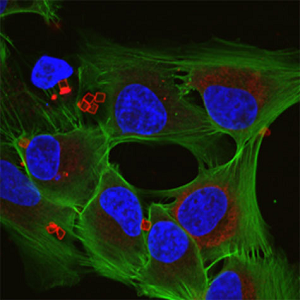 |
| Human breast cancer cells with red cubes for drug delivery--Courtesy of UAB |
Researchers at the University of Alabama at Birmingham have designed "smart" nanoparticles for cancer drug delivery, and they've found that changes in shape and elasticity could play an important role in their effectiveness as treatment carriers.
UAB's Eugenia Kharlampieva and her team presented their nanoparticles with three challenges that represent their ability to overcome drug delivery hurdles: avoiding the body's macrophages, squeezing through small holes in unhealthy blood vessels and being absorbed by tumor cells. They tested four different kinds of particle--spherical and cube-shaped particles both rigid and flexible.
The particles themselves are made of either silicon dioxide (spheres) or manganese carbonate (cubes). The scientists controlled elasticity by either leaving a scaffold in place within the particle or removing it with an acid.
The scientists found that elasticity played the most important role in avoiding macrophage engulfment and squeezing through tiny openings, regardless of the shape of the particle. The structural flexibility allowed them to both avoid detection and, after squeezing through a small opening, bounce back to retain their previous shape.
In getting to the cancer cells, the scientists found that shape played the more important part; the cubes were more likely to cover the greatest surface area on the cell.
So there was a clear winner of the four types of cells tested: "Our data show that elastic cubical capsules possess important biological characteristics, which can warrant their further development for cancer therapy," Kharlampieva and her team wrote.
- here's the UAB report